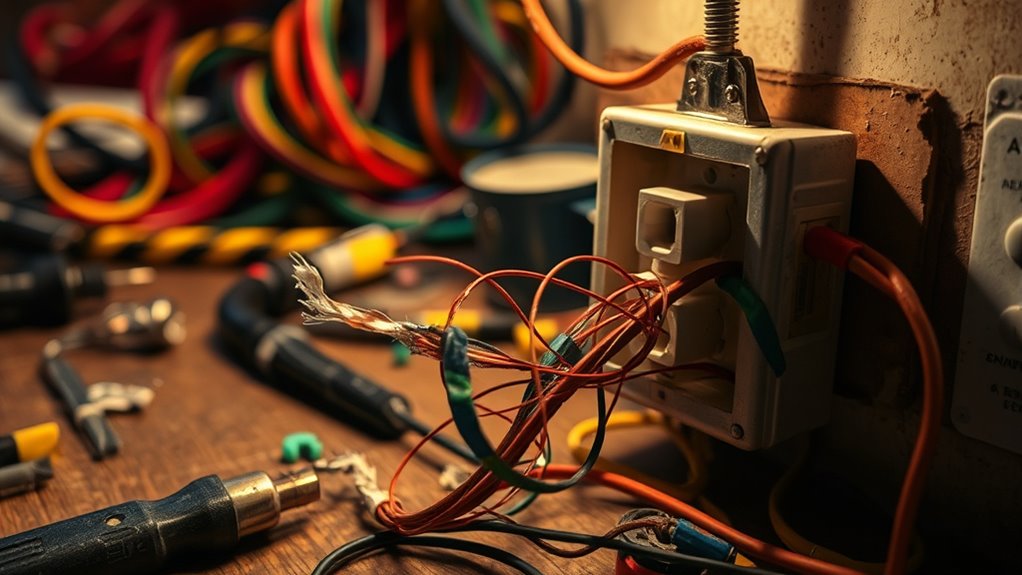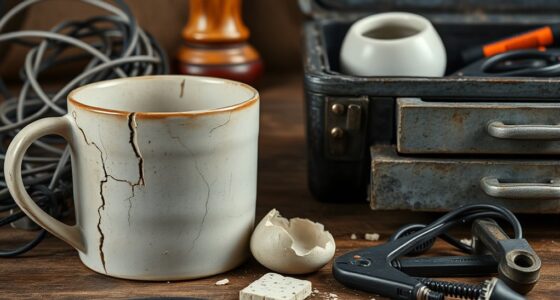Attempting DIY electrical fixes can hide serious dangers, such as shocks, burns, fires, and long-term damage. Common mistakes include ignoring safety steps, using incorrect tools, or missing code compliance, which increase risks of faulty wiring and hazards. Overlooking signs of wear or damage might lead to hidden issues that worsen over time. If you keep exploring, you’ll discover essential safety tips to help you avoid these hidden dangers and protect your home.
Key Takeaways
- Ignoring safety protocols can lead to electrical shocks, burns, or fires due to improper handling of live wires.
- Faulty wiring or poor connections may cause long-term damage, hidden hazards, or increased risk of electrical fires.
- Overloading circuits or misusing materials can result in overheating, sparks, and potential house fires.
- DIY repairs often overlook electrical codes, risking code violations, insurance issues, and unsafe home conditions.
- Complex electrical problems should always be handled by licensed electricians to prevent hidden dangers and ensure safety.
Common Mistakes Made by DIY Enthusiasts
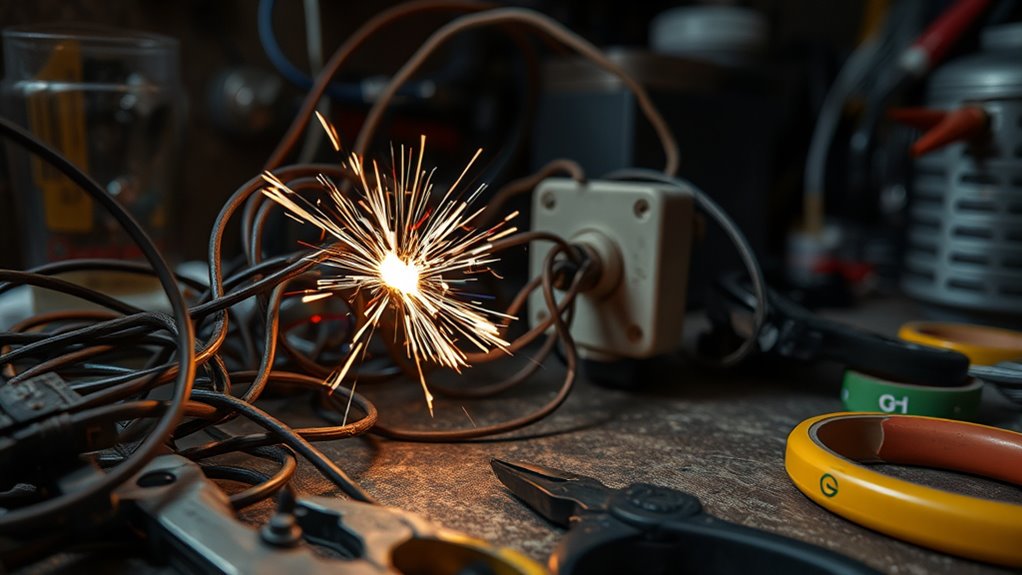
Many DIY enthusiasts overlook essential safety steps or underestimate the complexity of electrical work. They often assume that following basic instructions is enough, but neglecting proper procedures can be dangerous. Ignoring electrical codes is a common mistake that can lead to faulty wiring, fire hazards, or failed inspections. Failing to turn off power before starting work is another critical error, risking shocks or burns. Some DIYers also underestimate the importance of using the right tools and materials, which compromises safety and compliance. Rushing through projects or skipping permits can cause serious problems later. Prioritizing DIY safety means respecting electrical codes and understanding that electrical work isn’t always as simple as it looks. Taking the time to learn and follow proper guidelines prevents accidents and ensures a safe, reliable fix. Additionally, understanding environmental considerations helps prevent damage to surrounding ecosystems during electrical repairs.
Risks of Electrical Shock and Burns
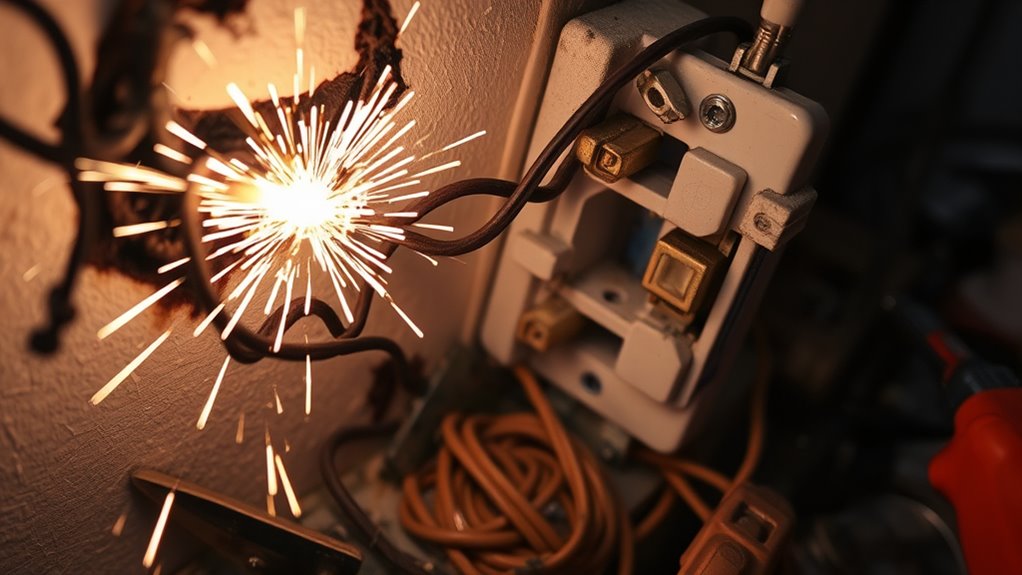
When you work on electrical projects without proper precautions, the risk of shocks and burns increases considerably. Faulty grounding issues can cause unexpected electrical surges, leading to severe shocks. Insulation degradation over time exposes live wires, raising the danger of accidental contact. Without proper safety measures, you might underestimate the power behind electrical components, risking injury. Understanding ethical hacking principles can help you recognize vulnerabilities in your safety setup and prevent potential hazards.
Be aware of these hazards:
- Touching exposed wires due to poor insulation
- Incorrectly installed grounding that fails under load
- Using damaged tools or parts that compromise safety
- Overlooking signs of insulation wear or degradation
These issues can result in dangerous electrical shocks or burns. Always ensure grounding is correct and insulation is intact before attempting repairs to minimize the risk of harm.
Fire Hazards Caused by Improper Repairs
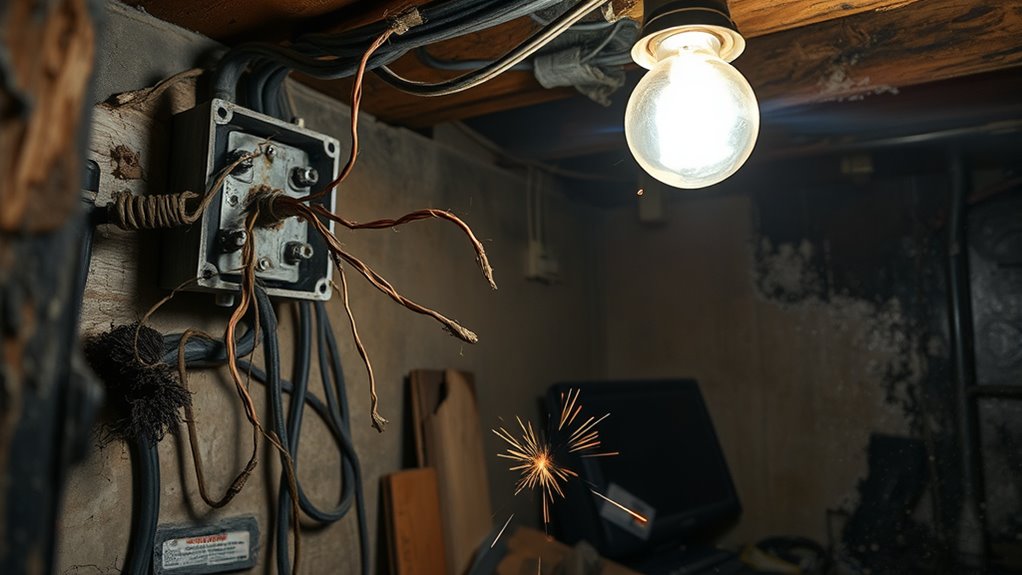
Improper electrical repairs can substantially increase the risk of fires, especially when safety protocols are ignored. Faulty wiring or circuit overloads often lead to overheating and sparks, igniting nearby materials. When you bypass proper procedures, you risk creating dangerous conditions that can escalate quickly. The table below highlights common issues:
| Issue | Cause | Risk |
|---|---|---|
| Circuit overload | Too many devices on one circuit | Overheating wiring, fire |
| Faulty wiring | Poor connections or damaged wires | Sparks, short circuits |
| Improper fixes | Skipping safety checks | Increased fire risk |
Ignoring these dangers can turn a simple repair into a costly fire hazard. Always prioritize professional help to prevent disaster. Additionally, incorporating security measures can help protect your property from potential fire hazards and other risks.
Hidden Damage and Long-Term Consequences
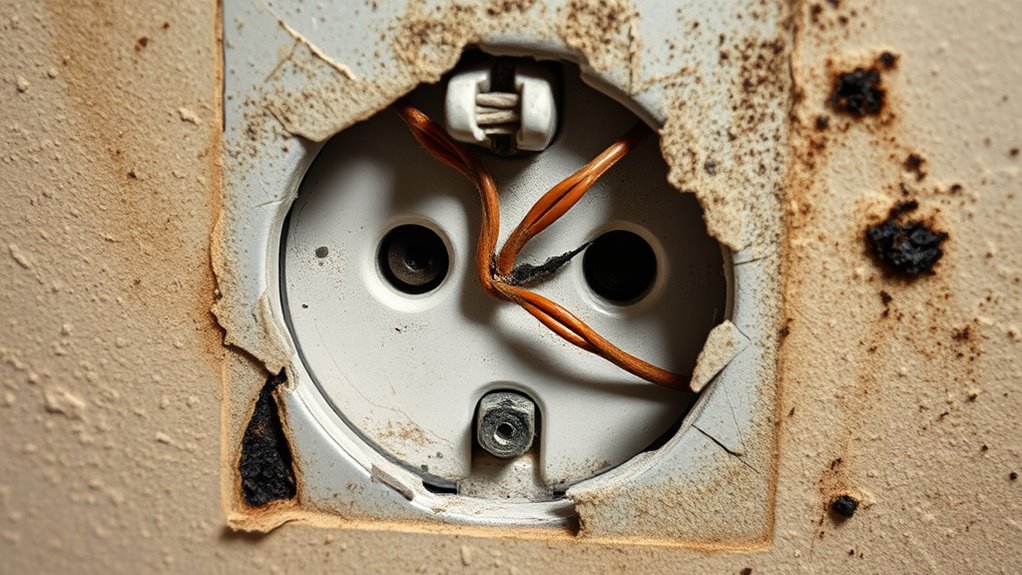
Even if a DIY electrical fix seems successful initially, hidden damage can silently undermine your home’s safety and stability. Over time, this concealed harm can lead to serious long-term consequences, often unnoticed until it’s too late. Hidden damage might include loose connections, insulation deterioration, or compromised circuit components that aren’t immediately visible. These issues can cause gradual overheating, increased wear on electrical parts, or even future failures. Be aware that ignoring small problems today can result in costly repairs later.
- Insulation damage that causes future shorts
- Loose wiring connections leading to arcing
- Corrosion weakening connections over time
- Overloaded circuits causing gradual deterioration
When to Call a Licensed Electrician
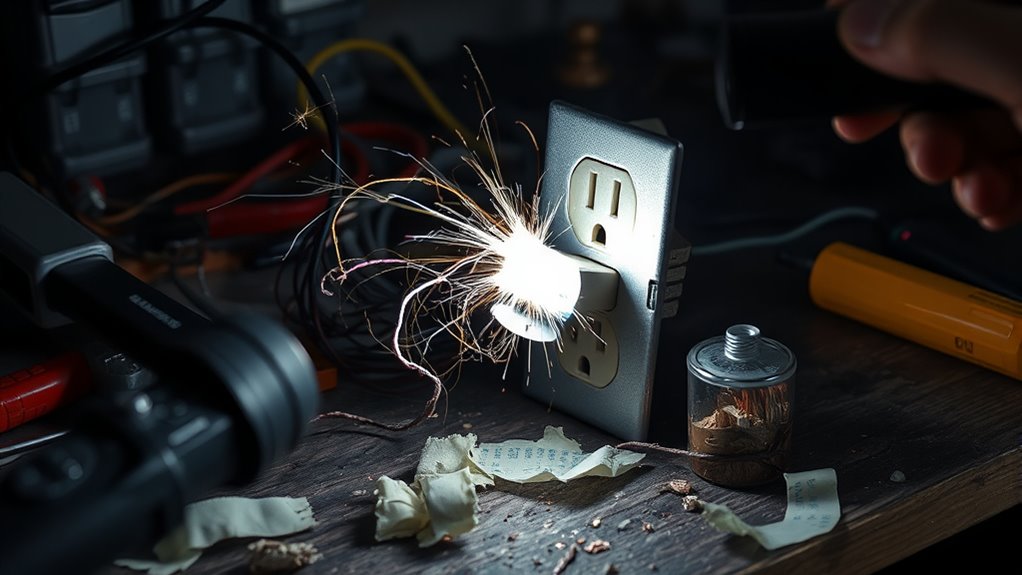
Knowing when to call a licensed electrician is crucial to guarantee your home’s safety and avoid costly repairs. If you encounter complex wiring issues, sparks, burning smells, or frequent circuit trips, don’t try to fix them yourself. These problems can lead to costly repairs down the line or even void your insurance coverage if improperly handled. Additionally, any electrical work related to main panels, breaker replacements, or rewiring should always be left to professionals. Attempting repairs beyond your skill level increases the risk of accidents and insurance claims being denied. Recognizing these warning signs helps prevent dangerous situations and ensures your home remains safe. When in doubt, it’s smarter to call a licensed electrician promptly rather than risking more significant damage or higher expenses later. Proper juice extraction techniques and safety precautions are essential when handling electrical tools and appliances to prevent accidents.
Frequently Asked Questions
How Can I Identify if My DIY Repair Is Unsafe?
To spot if your DIY repair is unsafe, start by checking for grounding issues, like loose or missing ground wires. Look for signs of overloaded circuits, such as frequent tripping breakers or overheating outlets. If you notice sparks, burning smells, or exposed wires, stop immediately. Always test your work with the right tools, and if you’re unsure, consult a professional. Safety should always come first to prevent accidents or electrical fires.
What Are Signs of Hidden Electrical Damage?
You should watch for signs of hidden electrical damage like flickering lights, a burning smell, or warm outlets, which indicate wiring hazards or hidden faults. If breakers trip frequently or switches feel hot, it’s a clear sign something’s wrong beneath the surface. Never ignore these signals; they point to potential dangers lurking in your wiring. Addressing these issues promptly helps prevent electrical fires and costly repairs down the line.
Are There Legal Penalties for Unauthorized Electrical Work?
Imagine wiring your home like a delicate dance—any misstep could lead to a costly fall. Unauthorized electrical work often breaks the law, risking hefty fines or even criminal charges. You must get electrical permits to guarantee safety and compliance. Ignoring this can also raise liability concerns if accidents happen later. So, always follow legal guidelines to protect yourself and your home from unnecessary penalties and hazards.
How Can I Prevent Future Electrical Hazards?
To prevent future electrical hazards, you should always follow safety precautions, like turning off power before working and wearing proper gear. Avoid DIY fixes if you’re unsure, and instead, seek professional consultation for electrical issues. Regular inspections by licensed electricians can catch potential problems early. Staying informed and cautious guarantees your safety and the safety of others, reducing the risk of electrical accidents and damage.
What Insurance Issues Arise From DIY Electrical Fixes?
You might think DIY electrical fixes are harmless, but they can turn your home into an insurance nightmare. If something goes wrong, your insurance claims could be denied, leaving you with sky-high repair costs. Without proper liability coverage, you’re risking financial ruin. Insurance companies often see DIY projects as negligent, so you could be left footing the bill for damages and injuries. Always consult a professional to avoid these costly pitfalls.
Conclusion
Before you pick up that screwdriver, remember that DIY electrical fixes are like walking a tightrope blindfolded—one wrong move can lead to a dangerous fall. Don’t let hidden dangers lurk in your walls or sparks ignite a fire you can’t control. When in doubt, call a licensed electrician to navigate the maze safely. Protect your home and loved ones; sometimes, the safest fix is knowing when to leave it to the experts.
